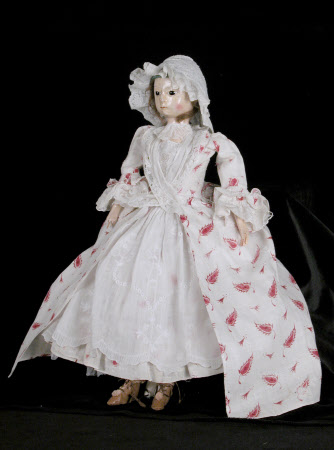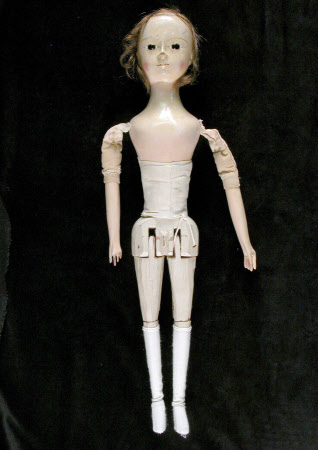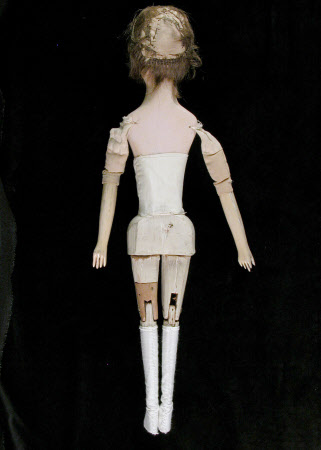Doll
Unknown
Category
Dolls
Date
1760
Materials
Cotton, gesso, glass, human hair, leather, linen, paint, wood
Measurements
485 mm (Height)
Place of origin
Unknown
Order this imageCollection
Dudmaston, Shropshire
NT 815064
Caption
Jane is a remarkable survival of a fashionably dressed wooden doll made in a London workshop in the early 1760s. She is wearing layers of clothing that replicate those worn by wealthy women of the time. From her underwear to outer gown and accessories, each item has been painstakingly created in miniature by the same milliners, staymakers and haberdashers that dressed fashionable society. In the 18th century, dolls were an important part of a young girl’s education. Through multi-sensory play, Jane’s first young owner would have become familiar with all the parts of adult female clothing she would wear in the future. Jane has been cherished and passed down through generations of the Wolryche-Whitmore family. She can be spotted wrapped in a red shawl in an 1881 painting of young Olive Mary Wolryche-Whitmore (NT 814212).
Summary
A mid-eighteenth-century doll known as ‘Jane’, likely to have been manufactured in London. ‘Jane’ is constructed of wood, with a turned body and jointed arms and legs. Her face and arms are carved and decorated with layers of gesso and paint and her head is finished with inset glass eyes and a wig of human hair. Dressed in adult female fashion c. 1760, she wears an open robe with a matching outer petticoat of white linen block-printed with an alternating pattern of madder-red stylised leaves and sprig motifs. Under her dress, her clothing is layered starting with a short-sleeved, knee-length linen shift, a pair of laced stays and a hoop made of linen and whale baleen, an embroidered linen under-petticoat, a pocket containing a handkerchief, cotton stockings and leather shoes decorated with ribbon laces and rosettes. Accessories include a cap, stomacher, sleeve ruffles, kerchief, frilled neckband and apron of diaphanous bobbin lace and whitework.
Full description
In the 1750s and 60s, turned wooden dolls with jointed limbs and delicately painted faces were manufactured in large numbers in London workshops for a home and British colonial market. Referred to as ‘babies’ despite being modelled on adult proportions, the most expensive, like Jane, were purchased ready-dressed in fashionable attire and given as expensive gifts to young girls. Jane is adorned with layers of clothing that replicate those typically worn by a fashionable woman of the early 1760s. From her underwear to outer gown and accessories, each item she wears has been painstakingly recreated in miniature. Unlike surviving garments of the 18th century which are only ever partial, Jane’s doll-sized clothing represents a complete outfit designed and constructed at a fixed point in time. Through play, her first young owner would have become accustomed to the component parts of adult female dress and how different garments were worn together, as well as developing knowledge of their material qualities. Childrens toys in the 18th century were designed to be gendered, pleasurable but instructive tools intended to prepare the young for the particular social roles and behaviours they were expected to adopt as adults. Dressed dolls were viewed as an essential part of elite female education and understood to embody the feminine thus encouraging play that supported traditional moral teaching on feminine virtues such as fidelity, modesty, and obedience.
Provenance
Dudmaston collection.
Makers and roles
Unknown, toy manufacturer




